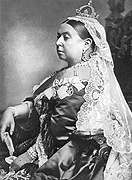Electronic Highways
What’s Victoria got to do with it?
While we often think of Victorians as excessively proper and very different from ourselves, they had an immeasurable impact on our everyday lives. Antiseptics, child labor laws, Christmas trees (their use came into fashion in England and America after an image depicting Victoria and her family around their tree was published), detective stories, postage stamps, sewer systems and the theory of evolution are some of the many things brought to us by the Victorians. And, whether or not we consciously acknowledge it, contemporary American culture has a deep-seated fascination with the Victorian period.
Queen Victoria ruled over the United Kingdom from 1837 to 1901, making her the longest-reigning English monarch. Victoria’s reign was a time of prosperity and colonial expansion. She oversaw a society in transition, one rife with creativity, curiosity and innovation. Victorians were responsible for advances in science and technology, political and social reform, and a wide variety of artistic and literary movements.
It was during the Victorian era that the novel came to dominate English literature. Many Victorian writers like Lewis Carroll, Joseph Conrad, Charles Dickens, Arthur Conan Doyle, Rudyard Kipling, Robert Louis Stevenson, Bram Stoker, William Thackeray, H.G. Wells, Oscar Wilde and the Brontë sisters are still read widely today. Two places to learn about lesser-known writers of the 19th century are the Victorian Women Writers Project, which began in 1995 at Indiana University, and Nineteenth-century Serials Edition, a project of the British Library and partners.
If you are interested in early motion pictures, Who’s Who of Victorian Cinema, which has information about early film equipment, as well as the expected biographies. Victorian photography is highlighted in the British Library’s Early photographically illustrated books, an online exhibit that features work by the medium’s pioneers.
There also are many sites that focus on the Victorian period more broadly. Victorian Web was developed by a community of scholars, many of whom were affiliated with Brown University. The site currently contains more than 50,000 documents and images covering all aspects of Victorian cultural sphere, including literature, philosophy, politics, religion, sexuality and technology. Indiana University Press' extensive Victorian Studies Bibliography lists noteworthy publications on the Victorian period and allows users to save citations in their "book bag" and download them in bulk.
Virtual Victorians originally was developed via a partnership of Tiverton Museum (Devon, England) and the University of Exeter. Their Day in the Life chronicles a week in the life of a working-class Victorian family. The interactive eToys section focuses on technology and play during the Victorian period.
The Victorian era also was Buffalo’s heyday, which is why Buffalo has such wonderful examples of Victorian architecture, as illustrated by Buffalo as an Architectural Museum.
Want to learn more about Victorian literature and culture? Why don't you think about taking a class? The Department of English (course list, Undergraduate Catalog 2010-11) offers “Victorian Literature” (ENG 322) and “Topics in Victorian Literature and Culture” (ENG 415).
The University Libraries also has many resources to help you engage in the Victorian period, including eBooks you can access without going to the library.
—Karen Walton Morse, University Libraries


Reader Comments